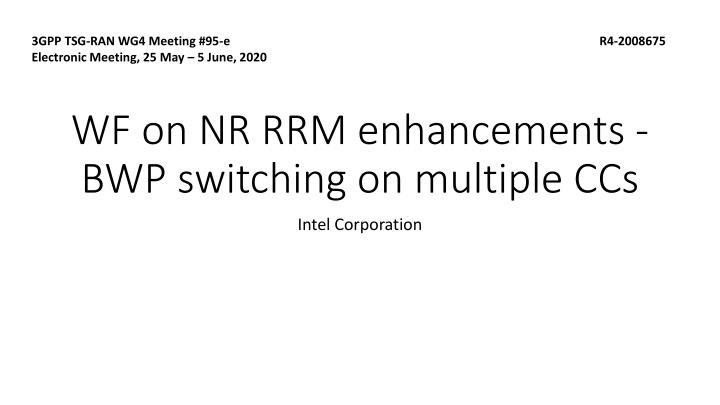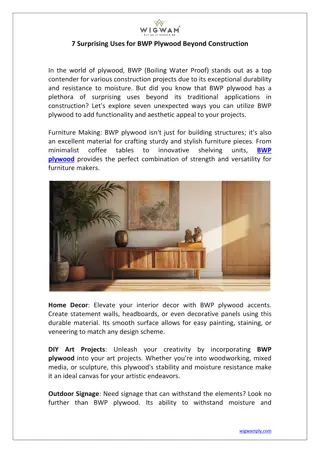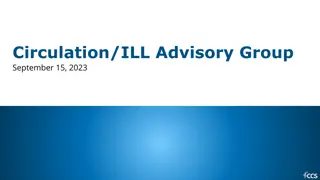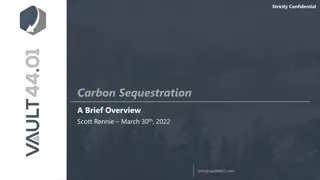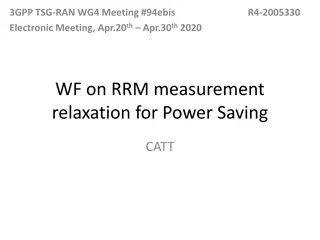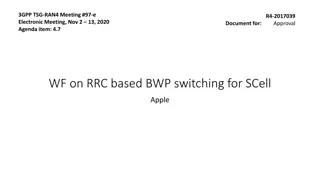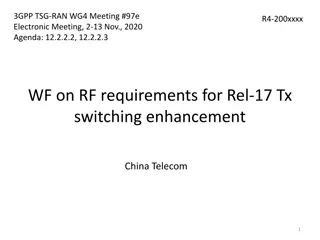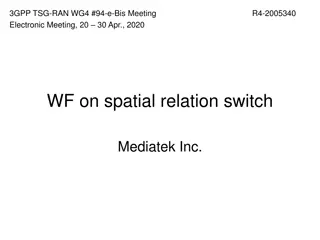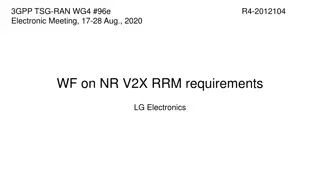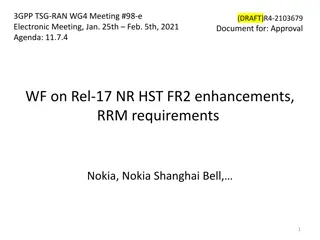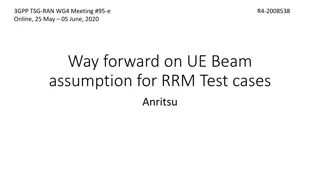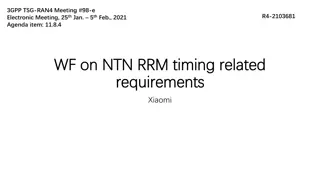NR RRM Enhancements: BWP Switching on Multiple CCs
The latest updates on NR RRM enhancements focusing on simultaneous BWP switching on multiple CCs, with details on delay requirements and UE capabilities for different scenarios."
Download Presentation

Please find below an Image/Link to download the presentation.
The content on the website is provided AS IS for your information and personal use only. It may not be sold, licensed, or shared on other websites without obtaining consent from the author.If you encounter any issues during the download, it is possible that the publisher has removed the file from their server.
You are allowed to download the files provided on this website for personal or commercial use, subject to the condition that they are used lawfully. All files are the property of their respective owners.
The content on the website is provided AS IS for your information and personal use only. It may not be sold, licensed, or shared on other websites without obtaining consent from the author.
E N D
Presentation Transcript
3GPP TSG-RAN WG4 Meeting #95-e Electronic Meeting, 25 May 5 June, 2020 R4-2008675 WF on NR RRM enhancements - BWP switching on multiple CCs Intel Corporation
Background Background In RAN4#94e-bis WF on BWP switching on multiple CCs was approved - R4-2005339
Simultaneous BWP switching on multiple CCs (1) Simultaneous BWP switching on multiple CCs (1) Delay requirements for DCI/timer based BWP switch ? ? 1); N: Number of CCs with simultaneous BWP switch; K is number of CCs that can be processed simultaneously; D is incremental delay for BWP switch processing on additional CCs ????????? ?????+ ? ( Value of D: - Agreement in 2stround: Define new UE capabilities for BWP switching on multiple CCs Type 1: D = 100us, 200us Type 2: D = 400us, 800us, 1000us Same capabilities apply for FR1 and FR2 Definition of N : - If SCS change is not involved in any BWP switch on multiple CCs For DCI and timer-based BWP switch on multiple CCs, for UE which is capable of per-FR gap, N is the number of simultaneous BWP switching on CCs within the same frequency range; For UE which is not capable of per-FR gap, N is the number of simultaneous BWP switching on both FR - Otherwise N is the number of CCs with simultaneous BWP switch
Simultaneous BWP switching on multiple CCs (2) Simultaneous BWP switching on multiple CCs (2) Delay requirements for RRC based BWP switch TRRCprocessing+ TBWPswitchDelayRRC + DRRC (N 1); Where DRRC is FFS. Option 1: DRRC= 0ms Option 2: DRRC= D (agreed value for DCI/timer based BWP switch) Option 3: if N<=3, re-use the existing requirement. if N>3, DRRC =D. where N is the total number of CCs.
Simultaneous BWP switching on multiple CCs (3) Simultaneous BWP switching on multiple CCs (3) ???????????????when SCS changes Agreement in 1stround: the simultaneous BWP switch on multiple CCs case, if the BWP switch on multiple CCs results in the change of the SCS on any CC among involved CCs, TBWPswitchDelayshould be based on the smallest SCS among all SCS values of all involved CCs.
Partial Overlap BWP switching on multiple CCs (1) Partial Overlap BWP switching on multiple CCs (1) Conditions when requirements for partial overlap BWP switch are defined DCI and RRC based BWP switch with partial overlap are defined for FR1+FR2 in NR-DC operation, when BWP switch doesn t involve SCS change and UE supports per-FR gap. - No requirement is defined for RRC based BWP switch with partial overlap within a cell group
Partial Overlap BWP switching on multiple CCs (2) Partial Overlap BWP switching on multiple CCs (2) Timer based BWP switch Sub1: if UE is capable of per-FR gap and the timer based BWP switch happens in two frequency range, whether UE handled timer-based BWP switch in parallel or sequentially Option 1: in parallel Option 2: sequentially
Partial Overlap BWP switching on multiple CCs (2) Partial Overlap BWP switching on multiple CCs (2) Timer based BWP switch Sub2: Delay requirement for timer based BWP switch Option 1: Don t differentiate UE capability of per-FR gap TBWPSwitchDelayPartialOverlapTimer= TDelay+ TBWPSwitchDelayTimer, where TDelayis the time delayed by ongoing BWP switching on other single or simultaneously triggered multiple CCs. TBWPSwitchDelayTimeris the timer-based BWP switch delay on current single CC or simultaneously triggered multiple CCs. Note: more clarification can be added for Tdelayand TBWPSwitchDelayTimerif identified necessary Option 2: Dependent on the UE capability of per-FR gap For UE capable of per-FR gap: TBWPSwitchDelayPartialOverlapTimer= TDelay+ TBWPSwitchDelayTimer, where TDelayis the time delayed by ongoing BWP switching on other single or simultaneously triggered multiple CCs within the same frequency range. TBWPSwitchDelayTimeris the timer-based BWP switch delay on current single CC or simultaneously triggered multiple CCs. For UE not capable of per-FR gap: TDelay+TMultipleBWPSwitchDelay, where TDelayis the time delayed by ongoing timer-based BWP switching with in the same frequency range; TMultipleBWPSwitchDelayis TBWPSwitchDelay+ D(N-1), N is the number of timer-based BWP switch on CCs in the other FR of which the time periods of BWP switching delay are overlapped with TNonSimultaneousTimer, and D is the incremental delay, which is same as that of simultaneous BWP switch on multiple CCs Note: more clarification can be added for Tdelayand TBWPSwitchDelayTimerif identified necessary
Partial Overlap BWP switching on multiple CCs ( Partial Overlap BWP switching on multiple CCs (3 3) ) RRC based BWP switch Sub1: Whether RRC processing time is equal to BWP switch time in RAN2 (In case the RRC procedure triggers BWP switching, the RRC procedure delay is the value defined in the following table (Table 12.1-1 in TS 38.331) plus the BWP switching delay defined in TS 38.133 [14], clause 8.6.3.) Option 1: Yes Option 2: No Sub2: Delay requirement for RRC based BWP switch Option 1:upper bounded by the multiple BWP switch time in CG1. Option 2:upper bounded by the RRC processing time in the 1st CG. Option 3:No need to introduce the waiting time for RRC based partial overlap BWP switching on multiple CCs, and the delay requirements for simultaneous BWP switch on multiple CCs shall be reused
